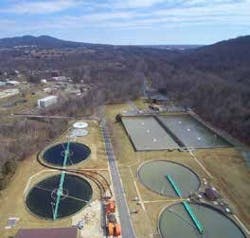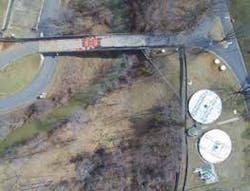Emergency Bypass for Sewer Facility Circumvents Natural and Manmade Obstacles
When operators at the Rivanna Water & Sewer Authority (RWSA) in Charlottesville, Virginia discovered a compromise in the 54-inch secondary effluent water line at their Moores Creek Advanced Water Resource Recovery Facility, they took immediate action to address the problem. The obvious solution was an emergency bypass, but the facility needed a temporary system that wouldn’t harm the creek or shut down the critical access bridge crossing it.
Solution
To get the repair done right and to put their minds at ease, RWSA called their local Xylem branch, the experts on emergency bypass projects. The authority had previously worked with the Xylem team, so they knew they would be in good hands.
“We needed to get it done fast, and we needed to get it done right,” says Tim Castillo, Wastewater Manager at the Moores Creek facility. “The expertise and capabilities that the Xylem team brings to the table is what we needed going in. They are a strong partner and they got it done as designed, and that eased a lot of concerns with our staff.”
The secondary effluent water line that the temporary bypass had to circumvent crossed from one part of the Moores Creek facility to the other. As a result, the bypass had to circumnavigate natural and manmade obstacles, including a number of clarifiers and the Moores Creek Lane Bridge. Since the bridge was the only access point to the back half of the complex and the authority’s administration building, shutting down the bridge for any length of time during the bypass was not an option.
The Xylem team immediately began mobilizing pipe and the necessary rental equipment for the temporary bypass. To handle the 30 million gallons per day (MGD) of flow that RWSA needed, the bypass would require three flanking lines of 18-inch high-density polyethylene (HDPE) pipe.
The length of the bypass turned out to be approximately 1,400 feet for each 18-inch line, and 5,000 feet of pipe was mobilized quickly from several Xylem rental locations. Once on location at Moores Creek, the pipe was fused and assembled by Xylem technicians, 500 feet at a time and then dragged into place and fused together.
To power the bypass, four Godwin diesel-driven, critically silenced CD400M Dri-Prime pumps were mobilized and installed. To save energy and diesel fuel costs, the pumps were installed and started sequentially, only coming online as needed.
Each of the three 18-inch lines had a dedicated pump capable of handling approximately 10 MGD of flow, and each pump was set up with a level transducer, which was pre-set to turn the diesel pumps on/off depending on fluid level in the wet well. If the system flow in a line increased, its pump was automatically activated. During lower flow, one or possibly two pumps would be running, but as many as three pumps would run during higher, peak-flow activity.
The fourth pump was an open-canopy redundant mechanical back-up that would kick-in if any of the other three pumps failed. For additional peace of mind, the bypass system included an alarm agent that was programmed to alert RWSA personnel if the pump wasn’t running at optimal levels, or was possibly approaching pump failure.
Results
Since the bypass had to negotiate the busy bridge without shutting down traffic, the Xylem team worked 24/7 shifts to expedite the installation, completing the installation in less than a week. Once the flank of pipes was in place across the bridge and across the line of traffic, three road ramps were provided to maintain bridge access during the month-long emergency bypass operation. Ultimately, the quick response by the Rivanna team, supported by Xylem team efforts and systems, was an example of the true environmental stewardship that RWSA is known for – with a vital focus on keeping their local streams and rivers safe from negative environmental impact.
Editor's Note: Scranton Gillette Communications and the SGC Water Group are not liable for the accuracy, efficacy and validity of the claims made in this piece. The views expressed in this content do not reflect the position of the editorial teams of Water & Wastes Digest, Water Quality Products and Storm Water Solutions.

